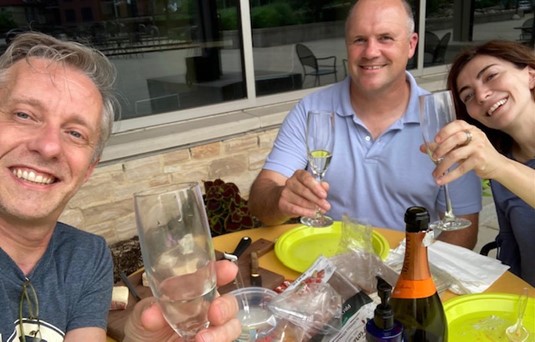
On May 30, 2020, a SpaceX rocket carrying two American astronauts was launched from NASA’s Kennedy Space Center in Florida. The first for a commercial spacecraft, the launch marked the start of a new era of human spaceflight, one in which traveling to space is becoming more accessible. It has reignited the conversation around sending humans back to the Moon and to Mars.
But exploring this new frontier comes with many new challenges, including concerns for astronaut safety. And while to some it might seem like the most dangerous part of the trip would be getting blasted off the planet on a tiny capsule driven by an enormous explosion, there is also risk once you get to space from the constant bombardment of tiny particles from outer space called cosmic rays.
Cosmic rays are highly energetic charged particles—mostly protons—that are accelerated by some of the most violent objects in the universe. They are harmless to us here on Earth’s surface because we are protected by Earth’s magnetosphere, the region of space around our planet that is dominated by a system of magnetic fields; the protection even extends far enough to reach astronauts on the International Space Station. But once humans embark on interplanetary trips, Earth’s magnetosphere can no longer shield them, which means humans are exposed to dangerous levels of radiation.
That’s a problem that Dr. Paolo Desiati of the Wisconsin IceCube Particle Astrophysics Center (WIPAC), a research center at the University of Wisconsin–Madison, is trying to solve. In collaboration with UW astronomy professor Elena D’Onghia and Kieran Furlong, a senior fellow at UW–Madison’s COWS thinktank, Desiati is developing a magnetic shield that will divert space and cosmic ray radiation away from a volume—functioning kind of like Earth’s magnetosphere. In addition to protecting astronauts and instrumentation from space radiation during interplanetary travel, the technology has another application: protecting quantum computers from the harmful decoherence effects induced by cosmic ray muon radiation on Earth’s surface.
The second application was recently patented by the Wisconsin Alumni Research Foundation (WARF), and the team has been awarded support from the Draper Technology Innovation Fund (TIF) for the work necessary to finalize and commercialize the concept. The innovation has also attracted the attention of private companies and was discussed at the highest government levels of the US and Italy.
Desiati, who has been at UW since 2001, is mostly responsible for the technical aspects of the project; for example, he performs all the calculations for the magnetic shield’s feasibility study. As the principal investigator on the Draper TIF award, he is also completing all the detailed studies of the magnetic shield for the quantum computing application.
He and D’Onghia have been working on a magnetic shield for a few years now; the idea was hatched during the pair’s weekly brainstorming sessions at a Madison coffee shop. “Although the idea of protecting astronauts from space radiation is not new, we thought that this would soon be a major issue at this dawn of a new space age,” says Desiati.
In 2019, they sought help from Discovery to Product (D2P), a UW–Madison research center that partners with a range of campus entities to advance entrepreneurial efforts. There, they were matched with a mentor, Kieran Furlong, and participated in innovator programs where they learned how to turn their idea into a marketable product. Furlong, a co-inventor on the WARF patent, is now helping them drive their technology toward a potential commercial application.
“Connecting with D2P was the best thing we could have done, as it gave us a business and commercial perspective on the idea we were starting to work on,” says Desiati. “D2P programs, with the invaluable mentorship of Kieran, expanded our horizons to a wide spectrum of possible applications for our magnetic shielding innovation. Never would I have imagined that the fast-growing quantum computing technology would eventually need to be isolated from the cosmic ray muons to prevent them from disrupting the quantum coherence required for real world operations—and that WARF would have accepted to file a patent on this.”
They have also gotten help from UW–Madison students. In fall 2020, Desiati and D’Onghia were “clients” for College of Engineering students in a freshman design course. As described in an article from the college, Desiati met weekly with the classes to teach them about cosmic rays and magnetic fields so they could prototype magnetic shielding system designs in groups and present their ideas to Desiati and D’Onghia.
Throughout 2021, the two collaborators also workshopped the magnetic shield’s advanced preliminary design with mechanical engineering and aerospace engineering undergraduate seniors. Desiati says that connecting with the “talented UW engineering students” was another boost in the development of their project.
Now, he and D’Onghia are seeking funding for the magnetic shield from NASA and other funding agencies.
“The pandemic has given Elena and me the energy to take our idea and transform it into useful possible applications,” says Desiati. “At our academic jobs, we work on pure scientific research. This new adventure has made it possible to apply some of this knowledge to the service of humanity and technology. Let’s see how far we get. So far it has been a real blast.”
Read more about the project:
- UW–Madison Astronomy Department article
- D2P Innovator Profile
- UW–Madison College of Engineering article
